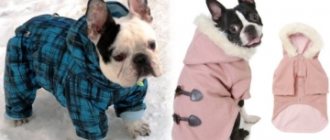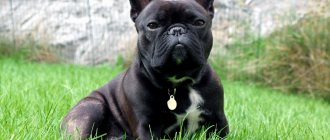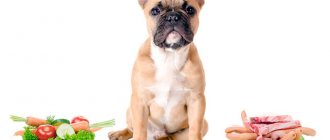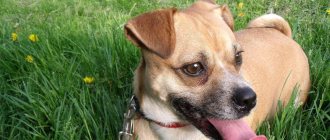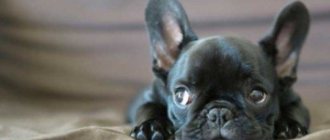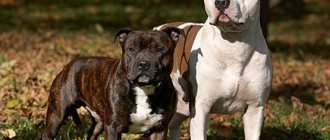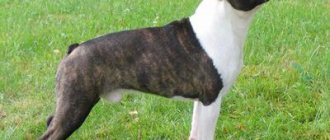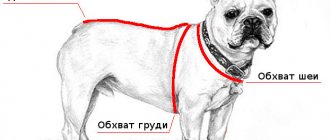At first glance, the pug and the French bulldog are almost identical breeds, but experienced dog breeders will argue with this statement. If you compare these animals, there are many differences not only in the exterior, but also in the characteristics of their habits.
The pug and the French bulldog are often confused due to their similarity in appearance
Advantages and disadvantages of French bulldogs
Bulldogs can be chosen as pets due to their many advantages:
- friendly disposition without a hint of aggressiveness;
- high intelligence;
- quickly finds a common language with children;
- a medium-sized breed can be safely kept in small-sized dwellings, such as apartments;
- has a playful and cheerful character;
- speaks only when necessary.
In addition to the advantages, it is worth noting several disadvantages of the breed:
- Loud snoring;
- intolerance to heat, so walks have to be carried out at strictly designated times of the day;
- problems with the eyes and respiratory system;
- stubborn disposition and excessive pride, which complicates training and education.
Note! The French Bulldog cannot swim.
Breed diseases
The situation regarding possible diseases of dogs is also interesting.
Pug - can be susceptible to various diseases such as: obesity due to its strong appetite; due to skin folds, infections are possible if left untreated.
Dental care is necessary due to the small space between the teeth.
Danger of encephalitis, epilepsy and susceptibility to respiratory disease and possible breathing problems due to high or low temperature.
Pugs also snore, but this is their specialty and don’t go to the hospital because of it.
The French Bulldog sometimes suffers from its large eyes, such as possible prolapse of the third eyelid and a predisposition to conjunctivitis.
Often, in certain pathologies, there are problems with a shortened nose; this will be heard due to constant snorting and grunting, the so-called brachycephalic breathing.
But if, under stress, the dog begins to snore or wheeze, but normally does not do this, then this is normal.
French Bulldog problems also occur with the back, sometimes due to hereditary genetics, or due to improper handling and inattention of the owner.
There are skin problems, but this is not a specific disease of the French, so you don’t have to think about it too much.
There is also a small difficult situation with breeding a bulldog, since only professionals are advised to do this; the birth of babies often occurs through a caesarean section.
Pros and cons of pugs
Compared to the French, pugs also have many positive qualities:
- goodwill and friendliness;
- affectionate disposition and attentiveness towards owners;
- playfulness;
- equilibrium;
- don't make much noise.
This breed also has its disadvantages:
- stubborn disposition and pride;
- distracting snoring;
- excessive shedding;
- susceptible to diseases of teeth and gums;
- too trusting of strangers.
Both dogs have both advantages and disadvantages
When does teeth change?
Dogs of this breed naturally have powerful jaws and even, strong teeth. When a French Bulldog is one month old, it should have a full set of baby teeth: exactly twenty-eight. At about three months, the dog should begin to change its first teeth to permanent ones, which, ideally, should end by seven or eight months. As a result, the pet should have forty-two molars.
Changing teeth is a very important period in the life of a French bulldog. Dogs may become nervous and moody due to pain. Sometimes she may have a fever.
During this period, the risk of disease increases. When a baby tooth falls out, it leaves an open wound that can become infected. Therefore, these days it is best to limit your pet’s interaction with other animals. Walks should be infrequent and short, and only on a leash, so that the owner has the opportunity to prevent the dog from trying to pick up anything from the ground.
Since the French Bulldog has a special muzzle structure, problems may arise when changing teeth due to deformation of the upper jaw. If it is delayed, then the teeth may grow crooked, in two rows, in the wrong place, rotated around their axis. The result of such anomalies can be jaw injury.
To avoid such complications, it is necessary to periodically inspect the dog’s mouth and brush its teeth using special devices (brush, paste, lotions, powder). At the slightest suspicion, you should immediately contact a canine dentist. Only a doctor can promptly remove baby teeth if they interfere with the normal growth of molars.
Also, the owner can independently help his pet during the change of teeth. You can give your dog large marrow bones, carrots, and dry food. All this helps to facilitate the change process and helps the development of jaw muscles. It is also worth contacting your veterinarian. He will advise what mineral supplements and in what quantities can be added to the French Bulldog's food if he has dental problems.
Main differences between breeds
A person who does not understand dog breeds easily can confuse a bulldog with a pug. They are really similar, but if you look closely, you can find many differences in:
- the size of the animals, since bulldogs are much larger than pugs in both height and weight;
- the shape of the head, muzzle and nose;
- body structure;
- coat type and color;
- paw shape;
- position and length of the tail.
The differences between the French pug and the bulldog are expressed not only in external features, but also in their character and habits. Pugs move with a kind of “rolling” step, due to the strong push of their hind legs. Therefore, this type of dog is not known for running fast. The movements of bulldogs are more confident, fast and smooth.
Meet the pug
This is an ancient breed, first brought to us from China, where these animals were considered traditional for the Chinese court nobility.
They measure about 360 mm at the withers and usually weigh no more than 8 kg. The build is stocky, the body geometry resembles a square.
- The pug's tail is a dense, tight curl, and sometimes even two curls - experts say that this shape is characteristic of purebred dogs. The curl always lies on its side, pressed against the thigh.
There are two colors - completely black, or beige-fawn with a dark, almost black mask. The coat is strong, short, with a pronounced shine, and very pleasant to the touch.
The coat needs to be brushed frequently because this breed sheds heavily. The eyes should shine brightly; dull eyes are a sign of poor dog health.
The eyes are very large for a muzzle of his size, so the dog always looks a little upset by the vicissitudes of life. Some experts who know the breed well joke that this is not sadness, but manifestations of a philosophical outlook on life.
But this impression is only apparent, as pugs have a sweet and cheerful character.
- When the owner returns from work in the evening, sincere joy from the meeting will be expressed in dancing on his hind legs, squealing, and obvious requests to “take him in his arms.”
Animals are quite active when they are in the mood for it. If the pug has a burst of activity, it continues until the end of the day.
But, in truth, dogs love much more to just sleep in the comfort of a pillow.
All lovers of this wonderful breed note the dogs' lively intelligence and their ability to train. However, they have such a trait as stubbornness.
If the pug becomes stubborn, he will not follow even perfectly familiar commands, and his owner will be forced to carry him home in his arms.
Breeders and specialist dog handlers know very well what to do with a stubborn little dog, but for novice dog owners this behavior can become a problem and a cause for concern.
A stubborn dog, sensing that something has not gone as desired, takes a stand and begins to bark loudly, persisting until someone comes up with something interesting to distract the pet. These dogs prefer order: it is important for them that things are in permanent places.
Appearance: differences and similarities
You can see external differences between breeds by visual inspection. The difference between pugs and bulldogs in exterior:
- the weight of a pug fluctuates around 2-9 kilograms, while a bulldog is almost twice as heavy - from 9 to 15 kilograms;
- the pug's muzzle is flattened, with pronounced folds, but in another breed it is longer, with an elongated nose;
- pugs' limbs are straight and parallel to the surface, bulldogs have curved legs with a vertical position;
- the ears of the former are lowered to the cheekbones, in bulldogs they stand straight;
- The tail of small pets is curled, while the large breed has a straight, low-hanging tail.
However, despite some differences, a pug and a bulldog have many similar features in their exterior:
- height at the withers of both breeds is about 35 centimeters;
- muscular and stocky body;
- short limbs;
- dark eye shade;
- short straight coat.
Pugs have a more flexible and loyal disposition.
Nutrition
To understand how a pug differs from a French bulldog, you should trace its diet and nutritional habits. The pug is a voracious animal that can steal food even from the table. Dogs of this breed are ready to chew any object they can get their hands on, for example, soap, shoe brush, slippers.
Both breeds are obese and require a balanced diet. It is best to feed a pug with fortified dry food, but without adding liquid (water, milk) to it. It is imperative to provide the animal with the correct drinking regime, given that water needs to be poured into the bowl twice as much as for an ordinary small dog.
Pug
It is allowed to offer your pug unboiled bones twice a week. An adult is allowed to feed three times a day, since frequent meals can lead to rapid obesity. This means you need to remember the rule: no food additives!
French bulldogs are less picky about their diet, but their diet should be taken as seriously as possible. The fact is that the animal is prone to allergic reactions, so only high-quality dry food is required. Homemade food is allowed, but only without hot spices and confectionery. A balanced diet for a bulldog includes:
- meat products;
- rice, buckwheat, other cereals;
- milk and fermented milk products;
- fish;
- fruit or vegetable slices.
The difference is that an adult dog needs to be fed twice a day, not three times like a pug.
Character
The character of both pets is dominated by playfulness and friendliness, so together these animals make an excellent team. Pugs are more flexible, so they blindly trust strangers. Bulldogs are independent, with protective qualities. They can fight back against an offender without any problems, unlike pugs.
Note! Despite the fighting disposition, the French breed cannot be called aggressive.
However, if we compare negative habits, then here too the pug and the bulldog have many similarities. Both pets have a proud and stubborn disposition. Sometimes it is difficult to make them obey, especially during walks or water procedures.
What is the difference between a French bulldog and a pug?
French bulldogs and pugs are excellent pet breeds. Both dogs get along well in small apartments and do not have special care requirements. At the same time, the breeds have a lot of differences - each pet not only has its own anatomical features and character, but even the history of its origin.
French bulldog and pug have differences
To purchase a purebred pug or French bulldog, it is recommended that you carefully study the standards of these breeds.
How the breeds differ - video
History of breeds
Pugs come from China; the first mention of them dates back to the 5th century BC. e. These dogs in the 1500s. were brought to Europe, where they became widespread. Only the nobility could afford such pets.
French bulldogs, despite their name, originate from England. They were started by dressmakers, whose dogs helped catch rodents. After the emigration of some needlewomen to England, the breed became widespread in the United Kingdom.
Pugs come from China
After the 1896 Dog Show, the value of French bulldogs increased significantly, bringing the price up to $750.
Exterior and anatomy - table
| Options | French Bulldog | Pug |
| Height | up to 35 cm | up to 32 cm |
| Weight | 8–15 kg | up to 8.1 kg |
| Ears | large and erect | thin, fit tightly to the skull |
| Body type | muscular and strong | muscular and short |
| Color |
|
|
| Neck | short and muscular | slightly curved and thick |
| Breast | wide | |
| Head | massive, square | large and round |
| Eyes | brown | |
| Tail | short, twisted | |
Character and behavior of breeds
Pugs are friendly companions. In their youth they are active, but in moderation. Upon reaching adulthood, they become sedentary and prefer the company of their owner and lying on the sofa. These dogs get along well with children and the elderly. Balanced character. Such dogs bite only in extreme cases.
French bulldogs, unlike pugs, are more stubborn and harder to train. They love to play and frolic in the fresh air. However, their character is calm and friendly. These pets are great for large families, but they should not be left without attention. Dogs of this breed are touchy and love to be played with.
French bulldogs love to play
When choosing a French bulldog, you need to be aware that he will have to pay enough attention. The pug is less picky in this regard.
Conditions of detention and nuances of care
Pugs are simpler in terms of nutrition - they do not require special privileges, it is enough to feed them 2-3 times a day. Your pet's diet should include:
- lean meat;
- milk;
- cottage cheese;
- offal;
- dry food;
- cereals and vegetables.
Pugs need to be fed 2-3 times a day
Unlike pugs, French bulldogs are prone to food allergies, so you need to choose the best quality food. This breed can be fed:
- meat;
- cereals;
- fish;
- vegetables;
- cereals;
- specialized food.
Bulldogs can be fed no more than 2 times a day.
Both breeds need clean water.
Food for French bulldogs should be selected carefully, as they are prone to allergies.
There are also differences in bathing breeds. Pugs can be bathed once every 6 months, provided that the dog is not often outside. If your pet regularly walks, then hygiene procedures should be carried out once a quarter. Such animals will have to be combed at least 2 times a week, as they shed quite a lot. You need to walk pets of this breed at least 3 times a week.
Bulldogs are easier to care for. They should be brushed no more than once every 7 days, as they do not shed as much as pugs. You can bathe bulldogs once every 2 months using a special shampoo. Dogs of this breed need to be walked daily. In cold weather, you will have to get warm clothes for your pet, since bulldogs do not tolerate frost well.
Both breeds require regular wiping of skin folds with a cotton pad and disinfectant. This method will prevent the occurrence of an inflammatory process.
Cost of puppies and adult dogs
Price of puppies:
- French bulldog - from 35 thousand rubles;
- pug - from 30 thousand rubles.
Cost of adult dogs:
- French bulldog - from 20 thousand rubles;
- pug - from 15 thousand rubles.
French bulldog puppies can't be cheap
The price of dogs depends on the class. Purebred breeds are the most expensive. If the price of a pet is too low, then you should keep in mind that the risk of purchasing a crossbreed is high.
Possible diseases
Pugs do not get sick often, but they are prone to such pathologies as:
- demodicosis;
- otitis;
- inflammatory diseases of the eyes and joints;
- urolithiasis disease.
The lifespan of such dogs varies from 12 to 13–14 years.
French bulldogs are more prone to inflammatory diseases of the skin, eyes and joints. The life expectancy of such pets is slightly shorter and is 10–12 years.
Both breeds require special skin care, as their skin is very delicate and prone to irritation.
Care and maintenance
There is virtually no difference in caring for both breeds. Due to intolerance to the temperature drop, pets have to buy special insulated suits. Dogs do not need frequent bathing; 2-3 procedures every six months are sufficient. However, pugs shed more profusely, so you need to purchase a special brush and brush their hair daily during this period.
Bulldogs are a more active breed and therefore require longer walks. In addition, they are more stress-resistant and do not tolerate the absence of their owner so hard. If kept in a country house in the summer, they can live in a special enclosure.
Representatives of both breeds should be walked early in the morning or late in the evening, when the heat begins to subside.
Attention! It is worth monitoring animals more closely in the summer and under no circumstances leaving them in a closed car in the heat.
Main characteristics of a pug and a Frenchie: similarities and differences
A comparison of a pug and a French bulldog proves that representatives of the breed seem the same only to people who are far from cynology. Animals have many of the same appearance features, but they have an order of magnitude more differences. Representatives of both breeds are similar in that they are small and stocky, their muscles are incredibly developed.
The main external feature that unites the animals is the presence of features inherent in brachycephals: both dogs are distinguished by their short, upturned muzzles and their interesting expression. At the same time, the animals’ facial expressions are different, since the French bulldog has an interested and friendly face, while the pug has a gloomy and serious face.
Appearance
The bulldog's ears are round and incredibly large compared to the head, like those of bats. Pugs have a smaller ear, it rises on cartilage. According to international standards, the French are allowed ears of a strictly established shape. Pug puppies have ears with ends:
- going down to the nose;
- thrown back.
The Frenchie's tail does not curl, but has a natural bend. In the Pug, the same part of the body is curled into one or two curls, which is considered a disadvantage for the Frenchie.
Pug. Photo from Wikipedia website
The dogs can be easily confused due to the light orange coloring with the darker mask present in both breeds. In addition, bulldogs, like terriers, have many shades of coat. Pedigree pugs have orange, black, and silver colors, which is unacceptable for the French.
Character
Pugs are distinguished by their friendliness, sociable nature, and they like to communicate with a large number of people. These animals often become attached to their owner, they are incredibly devoted to him. Pugs are great with kids, strangers, and other pets.
A negative feature of representatives of this breed is that pugs are bullies and fighters, rushing at larger dogs. Even if several pugs have lived in a common room since birth, they can fight for any reason. Young animals of this breed are distinguished by stubbornness, obstinacy, and self-will. A pug can get out of control if it is not properly socialized or raised.
French Bulldog
French bulldogs are friendly and easily make friends among people and animals. They can protect their owner and his property from criminal attacks, and are often used to catch rats, just like in the old days.
The French are wary of newborns, but love to play with older children. They are not aggressive towards strangers or pets, but are extremely jealous. Bulldogs may treat their owner poorly if they see him giving attention to another dog. They are often aggressive towards the animal that is more beloved by the owner, bullying him over trifles.
Health
Representatives of both breeds can be classified as long-livers, since their average life expectancy is twelve years. The appearance of the animals proves the presence of a flat, short muzzle, which causes problems with inhalation or exhalation.
Dogs of this type have large, protruding eyes that can easily be injured. They often suffer from corneal damage, cataracts, and prolapsed third eyelids. Pugs have specific ailments, for example, epileptic seizures, atopic dermatitis, food allergic reactions, hay fever.
Pug
The French are susceptible to ailments that also affect the human skeleton. Representatives of this breed exhibit narrowing of the nasal passages, entropion of the eyelid, and inflammatory processes in the cornea of the eye. Representatives of both breeds cannot give birth to puppies on their own, so experts resort to caesarean section. Bulldogs suffer from deformed intervertebral discs, which sometimes do not fully develop.
Education and training
The pug has better prerequisites for following commands, since the breed has a more trusting and loyal disposition. But in general, the pug and bulldog are not that easy to train.
To avoid disobedience and excessive pride, raising a puppy should begin as early as 3 months of age. At first these should be simple commands: “No!”, “Place!”. After this, you need to accustom the baby to his personal place and tray. Training should be undertaken no later than 6 months of age.
Both breeds are susceptible to the same diseases.
What to do if your ears don't stand up
Dogs of the French Bulldog breed have open, vertical ears. When you look at them, you can see the resemblance to the ears of a bat. Due to the small size of the animal's head, its ears appear quite large. They have a wide base and an oval line at the end.
But, unfortunately, not all French bulldogs have ideal “flying” ears of the correct set. Basically, they get up when they are supposed to due to their genetic predisposition. That is why when choosing a puppy of this breed, experts advise first examining its parents.
Ideally, dogs of this breed have ears that stand up by two months. If the puppy's ear cartilages are too heavy, then they may stand up much later, around three to four months. In rare cases, this happens when the animal is six months old. But this is most likely the exception rather than the norm.
It is worth noting that until the dog’s ears stand up, you cannot stroke its head. Otherwise, the ears may either not stand up at all, or stand up not vertically, but in different directions.
You shouldn’t wait six months if your French bulldog’s ears still haven’t grown at four or five months. The owner will have to make some efforts to help the pet's ears develop. First of all, you need to make changes to the dog's menu. To do this, you need to add calcium, cottage cheese, kefir and gelatin to your food.
The dosage of mineral supplements should be discussed with your local veterinarian, otherwise your pet may experience an overdose of medications. This will be bad for your French Bulldog's health.
If changes in the dog's diet do not help the process of ear formation, the owner will have to glue them back. To do this you need to prepare the following items:
- wide patch;
- medical cotton wool;
- bandage.
First of all, you need to roll two rolls of cotton wool five centimeters wide. The length of the roller should be two centimeters longer than the length of the French bulldog's ears. To strengthen the structure, each roller must be wrapped with a bandage.
Then you need to insert a roller vertically into each dog’s ear. Each ear must be carefully pulled out and the roller closed with its edges. Now you need to secure the resulting structure with a wide plaster, making sure that there are no folds on the skin.
Since the French Bulldog's ears must stand not only vertically, but also symmetrically, you will have to do something else. Two identical strips are cut from the patch, the length of which is equal to the sum of the distance between the ears and the length of the base of the two ears. One strip is glued horizontally in front of the ears, the other - behind.
The dog must carry the resulting structure for ten days. After this, the animal’s ears must be given a rest by removing the patch with vegetable oil and removing the rollers. If one time is not enough and the dog’s ears still do not stand up, the procedure must be repeated.
Upbringing
To ensure that positive emotions from purchasing an animal do not turn into negative ones due to its behavior, you need to engage in education. This includes training and teaching them to be agreeable.
Command training and training
You need to start training your puppy from the age of two months, so that he gradually remembers commands such as “place”, “sit”, “come”. Dogs of this breed rarely bark, so many owners consider this “voice” command unnecessary.
Further training should be based on the dog's temperament. To do this, you need to observe the dog before training it.
- For a choleric bulldog, you need to adhere to strict training, because if you do it in a playful way, the dog will not obey. It is necessary to clearly distinguish between reward and punishment. Also, you should not alternate excitation and inhibition commands, for example, “fetch” and “fu”.
- A phlegmatic bulldog, on the contrary, is easier to train in a playful way. He should be rewarded even for the easiest commands so that he does not lose interest. This type of dog reacts quite painfully to being handed over to the wrong hands, so it is better to train them yourself.
- The melancholic bulldog is the most complex type. He is very difficult to train. Dogs of this type will only follow commands if they are very attached to their owner and will strive to please them.
- The sanguine bulldog is the easiest to train. He immediately understands what they want from him, and any training suits him.
Tray and walking training
To toilet train a dog, you need to observe how the puppy behaves when he wants to go to the toilet - usually puppies start spinning in place and whining a little - and when he starts to behave this way, simply take him to the right place. Gradually the dog will get used to going there on its own.
7 days after all the necessary vaccinations, you can accustom the dog to walking. To do this, immediately after each feeding you need to take the puppy outside in your arms, preferably to the same place.
The puppy should not go down the stairs on his own, because this can damage the spine. Just like with the toilet, the dog gradually gets used to walking
It is very important to take proper care of your dog, but it is equally important to love it and spend enough time with it.
Character and psychological portraits
The psyche of pugs and French bulldogs, as well as their breed qualities and behavior, has more significant differences than their appearance. Thus, pugs are more flexible, they are loyal to people and other animals, they are wonderful dogs for the family, gentle and sensitive friends of children of any age. A typical pug is obedient, loves affection and attention from its owner, and is easy to train. However, you shouldn’t demand much from a pug - these dogs are not suitable for the role of active athletes, and you won’t be able to achieve much success in training a pug either. A cute dog is able to learn basic commands and follow the rules established in the house, but he cannot be called a working dog.
Briefly about pugs
The pug is from 25 to 33 centimeters tall, weighing from 6 to 8 kilograms. Despite their miniature size, they have a strong, stocky build.
A large square head, a wrinkled muzzle, large expressive eyes and button ears are the main features of the dog’s appearance. Color, like the French bulldog, can vary from fawn, silver-gray to black.
When looking at a pug, it seems that this dog is slow, loves to lie around, be lazy and sleep. In fact, this is not so - pugs are active, have a cheerful, playful disposition and are never averse to moving around and playing.
In addition, the dog is quite balanced, easy to train, and once accustomed to its owners, it will be the most affectionate, devoted and loving life partner.
Pugs love children and get along well with other animals—they may even become friends with your cat! They are also distinguished by their intelligence and intelligence, and will always come to the aid of their owners - they will react to noise and warn of danger.
Description of pugs
Pugs belong to an ancient breed, imported from China, which belonged mainly to the nobility.
At the withers they have only 360 millimeters and a maximum weight of about 8 kilograms. The body is square with a stocky build.
The coat comes in mainly two colors: black or beige with a black mask, while being short and shiny.
The pug has large eyes, which give the impression that the dog is running around with a sad expression on its face.
Character is pleasant, cheerful, balanced. Sometimes they tend to be active, but prefer to sleep more.
If a pug gets a surge of activity, then it cannot be stopped for a very long time.
The pug is very smart and highly trainable, but they do have one trait: stubbornness.
Because sometimes the dog may even refuse to go home on a leash and you will have to carry it.

